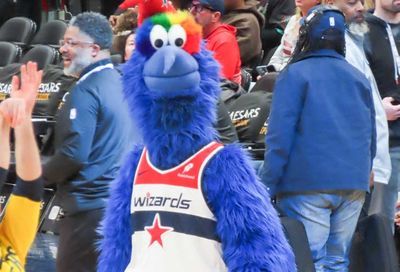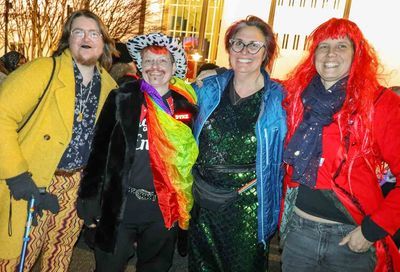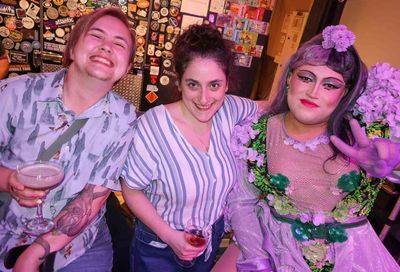100 Percent Cotton
Alphabet Soup
The first piece of gay-related clothing that I acquired — back when I was still in the practice of acquiring gay-related clothing and accessories — was an absolutely precious T-shirt with a black and white photograph of 10 diaper-clad babies spanning two rows. One of them was sporting a bright pink diaper.
I was 21 years old. I was then and am now a huge admirer of babies and I was then (and am now) a lesbian who was perfectly happy for the whole world to know that fact about me. To me, the T-shirt represented the perfect synthesis of two of my preoccupying passions: adoring tiny humans while making larger, older humans aware that I was gay and unashamed.
Somehow I’d gotten myself on a mailing list for a company that marketed gay kitsch — T-shirts, necklaces, earrings, bumper stickers, and so on, and so on. Each month, or however often this catalog published, I would get my copy in the mail, pore over the photographs of actual real-life gays (it did actually occur to me that they were models, but most of them looked so gay that they had to be real-life gays, they just had to), and contemplate a purchase.
The paraphernalia at that time was split pretty evenly between rainbow-themed goods and triangular pink imagery; this was before the yellow-on-blue equality symbol was even invented. (I mean that literally, kids. National gay organizations hadn’t yet discovered the lucrative homosexual fashion market.)
So the triangularly pink-diapered baby caught my eye because it was bold and cute, exactly how I was feeling the day I placed that order circa 1992. I remember wearing the shirt to my workplace when I went in one evening to pick up my check — I hadn’t made any big public announcements about my proclivity for pink triangles and all that they symbolized yet, but people were slowly catching on.
I believe somewhere near that time I’d also acquired a little interlinked women’s symbol earring that I was wearing in the second piercing in one ear; I’d bought it on a trip to D.C. with my first serious girlfriend and felt especially daring when I wore it. So when I walked into the Iowa newsroom where I worked at the time, I knew I was sending a specific message out, but only to those who were paying attention.
Imagine my surprise when a then-closeted coworker (who surprised absolutely none of us by coming out a few years later) said, “I don’t get what your shirt’s supposed to mean.” Another male editor, who was openly heterosexual, said, “Geez, even I get it” — the implication being “I’m straight, clearly you’re not, and I’m the one who gets the stupid shirt?”
One of us explained what the shirt meant, and we all went about our merry way. I later acquired a set of “freedom rings” (remember those? kids, check your gay history books), and when the aforementioned serious girlfriend and I broke up, I inherited her “100% Dyke” T-shirt — funny at the time because she was openly bisexual, and funnier now because she ended up marrying a man.
At some point I slapped a pink triangle sticker on the car I used to drive. Most of these things occurred before I moved out of Iowa, where I felt the need to make a statement, and into the big progressive city, where it seemed like tens of thousands of others had already made the statement and there was nothing left for me to say.
But I stopped collecting gay garb somewhere along the way, probably not long after I bought my 1993 March on Washington T-shirt, and started collecting gay life experiences instead of gay logos.
The image of that pink-sporting baby is burned in my mind, though — it made such a strong impression on me at the time, as I was in the infancy of my out-and-proud lesbianism.
It declared that we are gay from birth, that people should be loved — from birth — no matter what color diapers they wear. And it asserted, boldly, that we are everywhere, that one in 10 people you meet are gay (or simply appreciate the color pink, depending on your interpretation), that one in 10 babies may grow up to be gay, and, most importantly, that it’s OK, that we can smile about that and celebrate it.
Soon I learned that the “one in 10” figure is subject to controversy, and our prevalence as a people might be lower than that. No one knows for sure, of course. But I started thinking recently about the other T-shirts that could be made with the one-in-10 theme.
Because it’s all the rage to fabricate fact from an online search, I consulted my friend Google.com, where a quick query for “one in 10” led me to some most fascinating discoveries — and some most compelling T-shirt ideas.
As with the gay figure, some of these statistics may be in need of further scientific documentation. I take no responsibility for repeating data that Google.com told me is true.
For instance, one in 10 people are affected by ID theft. One in 10 Kansas households go hungry. One in 10 drivers have poor eyesight. One in 10 grandparents are full-time parents to their children’s children. One in 10 people are affected by ID theft. One in 10 Russian prison inmates have tuberculosis. One in 10 spam e-mails push pharmaceutical rip-off drugs. (I don’t read most of my spam, but I sense that this one may be underreported right now.) Almost one in 10 women under 25 are infected with potentially damaging chlamydia. The United Kingdom’s “fat epidemic” leaves one in 10 6-year-olds obese. And, most shockingly of all, only one in 10 Japanese people support whale hunting.
I’m not sure what color diaper goes on the special babies on each of those shirts, but the little whale pattern is bound to be cute.
Kristina Campbell and her collection of vintage homosexual T-shirts live in Takoma Park. One in 10 of those T-shirts could net between one and 10 dollars on eBay. But don’t wait for the auction — e-mail her and make an offer at kcampbell@metroweekly.com.
Support Metro Weekly’s Journalism
These are challenging times for news organizations. And yet it’s crucial we stay active and provide vital resources and information to both our local readers and the world. So won’t you please take a moment and consider supporting Metro Weekly with a membership? For as little as $5 a month, you can help ensure Metro Weekly magazine and MetroWeekly.com remain free, viable resources as we provide the best, most diverse, culturally-resonant LGBTQ coverage in both the D.C. region and around the world. Memberships come with exclusive perks and discounts, your own personal digital delivery of each week’s magazine (and an archive), access to our Member's Lounge when it launches this fall, and exclusive members-only items like Metro Weekly Membership Mugs and Tote Bags! Check out all our membership levels here and please join us today!



















